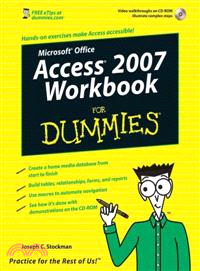| FindBook |
有 1 項符合
ACCESS 2007 WORKBOOK FOR DUMMIES的圖書 |
 |
ACCESS 2007 WORKBOOK FOR DUMMIES 作者:STOCKMAN 出版社:JOHN WILEY & SONS 出版日期:2007-11-21 |
| 圖書館借閱 |
| 國家圖書館 | 全國圖書書目資訊網 | 國立公共資訊圖書館 | 電子書服務平台 | MetaCat 跨館整合查詢 |
| 臺北市立圖書館 | 新北市立圖書館 | 基隆市公共圖書館 | 桃園市立圖書館 | 新竹縣公共圖書館 |
| 苗栗縣立圖書館 | 臺中市立圖書館 | 彰化縣公共圖書館 | 南投縣文化局 | 雲林縣公共圖書館 |
| 嘉義縣圖書館 | 臺南市立圖書館 | 高雄市立圖書館 | 屏東縣公共圖書館 | 宜蘭縣公共圖書館 |
| 花蓮縣文化局 | 臺東縣文化處 |
|
|
- 圖書簡介
Do you wish Access was more accessible? Do you wonder what to do with databases in the first place? If you’ve just been letting Access sit there as an anonymous icon on the Ribbon, Access 2007 Workbook For Dummies can open up new worlds for you.
The coolest thing about this friendly, easy-to-follow workbook is that you’ll actually create a database that you can use to organize your own home media collection, if you like. In the process, you discover how to build a database from the ground up and some of the ways a database can be helpful, even if you’re not a business mogul or an accountant. Using a problem-solution approach, Access 2007 Workbook For Dummies gives you plenty of chances to practice each step, so you gain confidence along with information.
You’ll discover how to:
Set up Access and use database fundamentals
Create a home media database from start to finish
Build tables, relationships, forms, and reports
Use select and action queries
View and manipulate data
Edit and build simple macros and use them to automate navigation
Arrange controls on a form
Build a user interface to add, edit, and update data
Track every aspect of the media collection, including
The bonus CD-ROM includes separate database files for each exercise and a video that walks you through each step of the more complex procedures. In no time you’ll find Access is no longer unapproachable.
Note: CD-ROM/DVD and other supplementary materials are not included as part of eBook file. - 作者簡介
Joe Stockman is an independent consultant, software designer, and author who has been using Microsoft Access since its initial release. He’s also developed courseware and taught classes in Access and VBA. Joe developed his first application in Access, and then migrated into Visual Basic and VB.NET, where he specializes in creating applications for the Windows Mobile platform. He’s worked for several software companies before forming his consulting business in 2002, where he deals with all types of clients including healthcare, financial, government, manufacturing, and small business. His ability to turn his customers’ wishes into working applications keeps them satisfied. Joe is the co-author of the Access 2007 Bible and Access 2007 VBA Programming For Dummies and also writes for the Advisor Guide to Microsoft Access magazine.
- 目次
Introduction.
Part I: Learning Database Fundamentals.
Chapter 1: Getting Started with Access.
Chapter 2: Managing Databases.
Part II: Creating and Using Tables.
Chapter 3: Creating and Modifying Tables.
Chapter 4: Entering Data in Tables.
Chapter 5: Viewing Data in Tables.
Chapter 6: Building Relationships.
Part III: Viewing Data with Select Queries.
Chapter 7: Creating Single-Table Queries.
Chapter 8: Creating Multi-Table Queries.
Chapter 9: Performing Calculations in Queries.
Part IV: Manipulating Data with Action Queries.
Chapter 10: Changing Data with Update Queries.
Chapter 11: Adding Data with Append Queries.
Chapter 12: Removing Data with Delete Queries.
Chapter 13: Creating Tables with Make Table Queries.
Part V: Building Forms.
Chapter 14: Creating and Using Forms.
Chapter 15: Basic Form Design.
Chapter 16: Changing Control Properties.
Chapter 17: Changing Form Properties.
Chapter 18: Creating Calculated Controls.
Part VI: Advanced Form Design.
Chapter 19: Formatting a Form.
Chapter 20: Arranging and Sizing Controls on a Form.
Chapter 21: Using Combo Boxes and List Boxes.
Chapter 22: Using Split Forms and Subforms.
Part VII: Building Reports.
Chapter 23: Creating Simple Reports.
Chapter 24: Changing Report Design.
Chapter 25: Grouping and Sorting Reports.
Part VIII: Automating Access.
Chapter 26: Adding Buttons to Forms.
Chapter 27: Editing and Building Simple Macros.
Chapter 28: Creating a Switchboard.
Chapter 29: Importing and Exporting Data.
Part IX: The Part of Tens.
Chapter 30: Ten Tips for Using Access Like a Pro.
Chapter 31: Ten (More or Less) Shortcut Keys for Using Access.
Chapter 32: Ten (More or Less) Shortcut Keys for Entering Data.
Appendix A: About the CD.
Appendix B: Exercises.
Index.
Wiley Publishing, Inc. End-User License Agreement.
|











